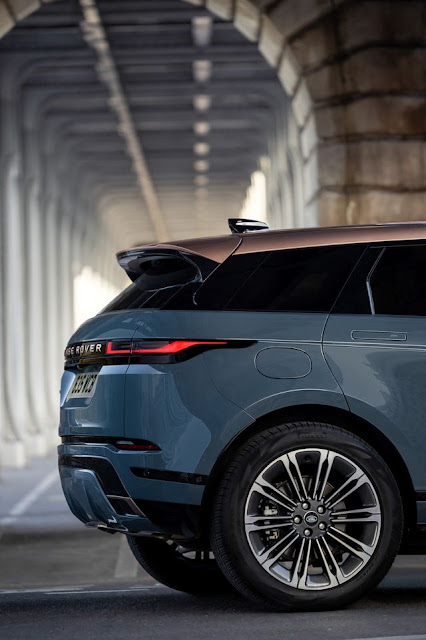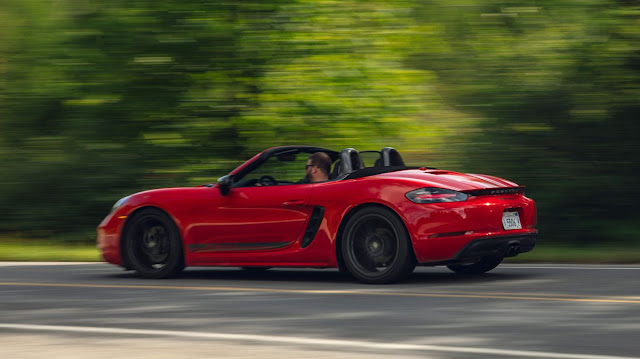2024 Range Rover Evoque Reduces to the Max
The pursuit of minimalism reaches the interior, with predictable results.
As Stanford University's Rob Kapilow explains, British art critic Richard Wollheim in 1965 "coined the term 'minimal art' to describe art that reduced its materials and forms to fundamentals." The phrase became the catchall "minimalism," which became—and remains—a vital ethos of Western design and culture. You can hear it in composer John Cage's "4:33," which puts a pianist at a piano for four minutes and 33 seconds of silence. You can sit in it with Arne Jacobsen's Egg Chair or anywhere at Ikea. You can sleep and shower in it, in modern hotel rooms that make Sphinxian riddles of turning off the lights and turning on the water. And you can drive it if you buy a Range Rover.
Evoque's Exterior Design
The British SUV maker prefers the term "reductive" design to minimalism. The 2024 Range Rover Evoque shows the result is the same no matter the term—better execution than in that boutique hotel, albeit just as stingy with switches and buttons.
Applied to the Evoque's exterior, reductive is a warning to expect changes that need a jeweler's loupe to identify. The grille swaps the previous hexagonal mesh for artful dashed lines, the Evoque now expressing the family genes as passed down by the paternoster Range Rover. On either side of the grille, slimmer adaptive headlights match the units used on the Velar. Each lamp houses four small lighting units, each unit housing 67 LEDs that can alter their light pattern so as not to blind drivers ahead.
Arroios Grey, Corinthian Bronze, and Tribeca Blue join the exterior paint menu, Corinthian Bronze also available as a contrasting roof color alongside Narvik Black.
Evoque's Minimalist Interior
Reductive design makes its real stand inside. In our review of the baby Range Rover from 2022, we wrote, "The Evoque's interior mirrors the clean design of its exterior, which is unfortunate because that means most of the knobs and buttons were banished in favor of touchscreens and capacitive switches." For 2024, touchscreen is now singular, the former infotainment and HVAC displays absorbed into an 11.4-inch unit higher up on the instrument panel. And the buttons and knobs? Mortal enemies of the reductive, erased as thoroughly as Leia's Alderaan.
Now that a single screen needs to lift the weight of two, there are two speed-dial menus along the sides of the 11.4-inch display and a quick menu for climate controls at the bottom. As before, Range Rover says approximately 80 percent of functions are within two taps of the home screen, but this really is a new smartphone interface: not exactly intuitive, easy enough to find what you want after pecking and swiping a bit, hiding heaps of shortcuts and functionality you'll never unlock unless you read the owner's manual. And, let's be honest, you probably won't.
Even phones have buttons for volume, though. In the Evoque, the volume slider is on the right-side-screen menu farthest from the driver, a suboptimal controller in a suboptimal location. Of course, the driver is meant to use the capacitive switches on the new steering wheel. At least the new wheel is a pretty piece of work—three muscular, dished spokes replacing the utilitarian button pods and twin spars on the old tiller.
Eliminating the bottom screen on the center console liberates space for a standard wireless phone charger and cubby. Below that, where once sat Range Rover's version of a Hurst pistol-grip shifter on a large metallic plinth, designers downsized the gear selector to snug into a palm and nestled it into the gently ramped trim. Behind it, two larger, equally sized cupholders replace the asymmetric holders.
Muted color palettes are an ancillary trend riding minimalism's coattails of late—prosaic, inoffensive hues turning homes into greige boxes and children's playsets into earth-tone Bauhaus mazes. The Evoque is attuned to the zeitgeist. Trim pieces come either in Shadow Gray Ash Veneer, dark anodized aluminum, or light anodized aluminum. The brightest available hue in the cabin is a light gray called Cloud, and even that is contrasted with Ebony.
Driving the Evoque
The reductive scythe took a swipe at the engine and trim choices too. Our market gets only the P250 powertrain, a turbocharged 2.0-liter Ingenium four-cylinder making 246 horsepower and mating to a nine-speed automatic. The pruned lineup counts only the S and Dynamic SE, as the HST and R-Dynamic variants have been dismissed, and with their departure goes the available 296-hp engine. Carryover front struts and a multilink rear axle connect the body to the wheels; front-biased all-wheel drive comes standard.
Since the mechanicals haven't changed, neither have our feelings about driving the Evoque: The enthusiasm here is more for fashion than handling. The turbo four has enough heart to survive the test of French highway on-ramps, which are so inexplicably short they require equal amounts of guts and timing to merge without catastrophe. When unstressed, the transmission executes shifts smooth enough to make gelato jealous. Even on the 20-inch wheels our sample Evoque wore, calm composure defines the on-road ride.
Prodding the gearbox into sudden acceleration, however, means waiting for it to downshift from the tall fuel-economy-focused ratios and then for the turbo to hit the necessary rpm. Attempts at spirited driving, down the French secondary roads along our drive route, prove the automaker's urban-focused mission for the Evoque. The vehicle's propensity to understeer, and its accurate, indifferent steering were about what you'd expect for a two-ton urban crossover. The mushy, long-travel brake pedal, however, bled our confidence.
The paradox of that squishy brake-pedal response is that it's perfect for off-roading, and dirt work is the Evoque's other defining feature after its fashion-runway styling. If challenged by competitors such as the Volvo XC40 or BMW X1 to race to the top of a snaking mountain pass, the Evoque would do best ignoring the road and driving straight up the hill.








